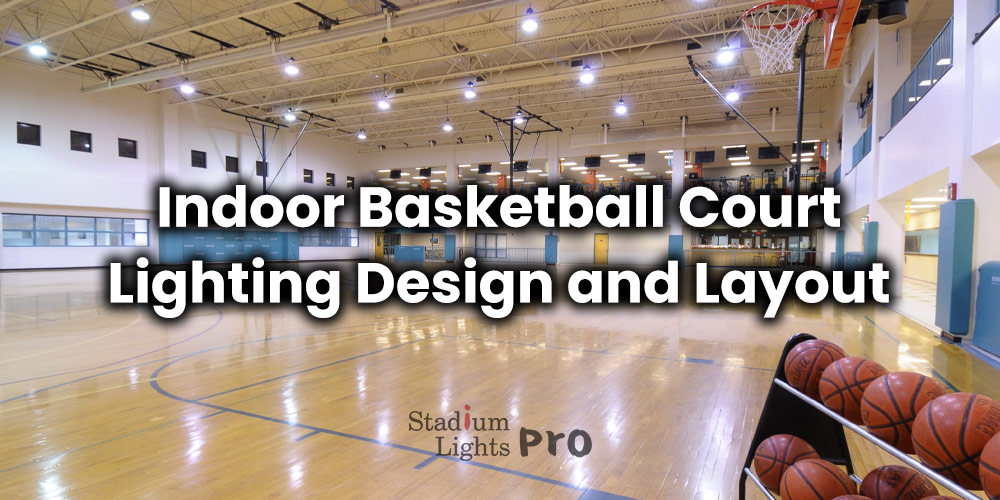Lighting in indoor basketball courts and gyms is essential for the safety and enjoyment of players and spectators. Adequate lighting is necessary for players to see the ball and court clearly, reducing the risk of injury from collisions or falls. It also enhances the overall viewing experience for spectators, allowing them to see the action clearly and comfortably. Additionally, proper lighting can help to improve the overall atmosphere and aesthetic of the court or gym.
The lighting in basketball gym can also have a positive impact on the performance of the players. Lighting that is too dim can cause players to miss shots or misjudge the position of the ball, leading to poor performance. Lighting that is too bright or harsh, on the other hand, can cause glare and shadows, also affecting the players’ performance.
Table of Contents
ToggleIndoor basketball court lighting design & standards
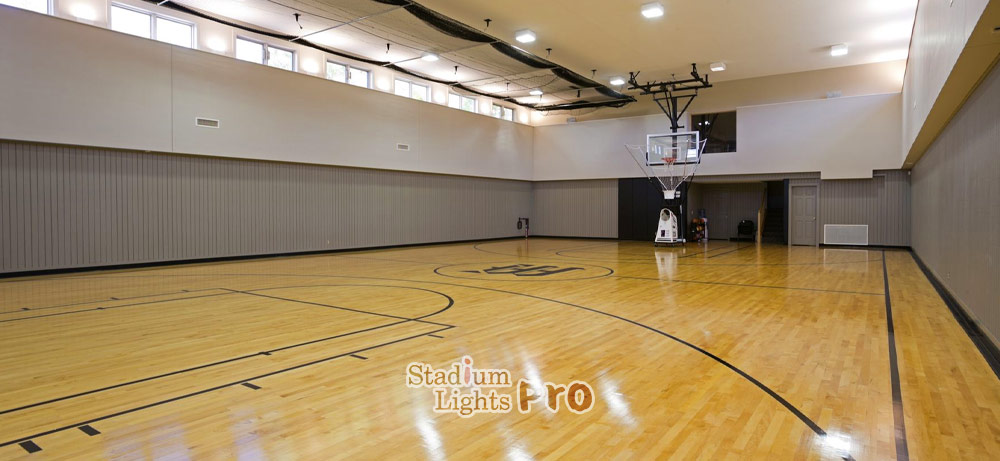
Basketball court lighting design is the overall planning and implementation of a lighting solution for indoor basketball courts. The main objective of the lighting design is to provide appropriate levels of light intensity, also known as lux or foot-candles, on the playing surface and surrounding areas. This ensures that players can see the court and ball clearly, reducing the risk of injury and improving their performance.
Designers consider various factors when planning the lighting solution, including:
- Type of lights used – High bay lights or flood lights are typically used in indoor basketball courts. High bay lights are best for high ceiling areas, while flood lights are best for illuminating the playing surface.
- Lux or foot-candles is a measure of the light intensity on the playing surface. Recommended levels of light intensity for indoor basketball courts range from 75-100 foot-candles.
- Lumen is a measure of the total amount of light emitted by a lighting fixture.
- Wattage is a measure of the energy consumption of a lighting fixture. Energy-efficient fixtures are typically preferred to reduce energy costs.
- Light uniformity refers to the distribution of light across the playing surface. A uniform distribution of light ensures that players can see the court and ball clearly, without glare or shadows.
- Color temperature refers to the color of the light emitted by a lighting fixture. Natural white light colors (around 4,000K to 5,000K) are preferred in indoor basketball courts, as they provide a more natural and comfortable light for players and spectators.
What types of lights are used in indoor basketball court?
UFO high bay lights
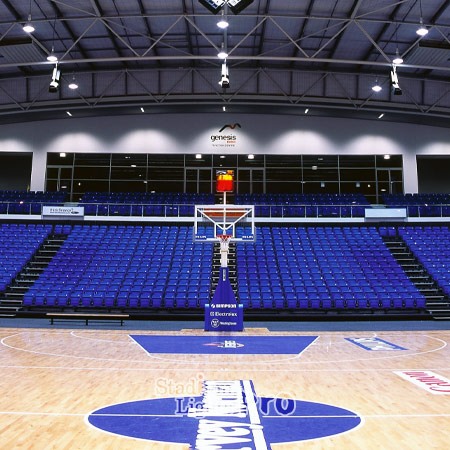 UFO high bay lights, also known as round or circular high bay lights, are a type of lighting fixture that are commonly used in high-ceilinged indoor spaces such as basketball courts and gymnasiums. They get their name from their UFO-like shape and are designed to be suspended from the ceiling.
UFO high bay lights, also known as round or circular high bay lights, are a type of lighting fixture that are commonly used in high-ceilinged indoor spaces such as basketball courts and gymnasiums. They get their name from their UFO-like shape and are designed to be suspended from the ceiling.
The high bay lights are known for their high lumen output, which makes them ideal for illuminating large, open spaces such as indoor basketball courts. They provide a wide beam angle that can cover a large area, making them suitable for illuminating the playing surface. They also have high energy efficiency, which can lead to cost savings in the long term.
Flood lights
They are designed to provide a high level of light intensity over a wide area, making them suitable for illuminating the playing surface of an indoor basketball court.
Flood lights come in various sizes and shapes, and they can be mounted on walls or ceilings, depending on the design of the court. They are also available in different wattages and color temperatures, which allows for flexibility in creating the desired ambiance in the court.
Recessed lights
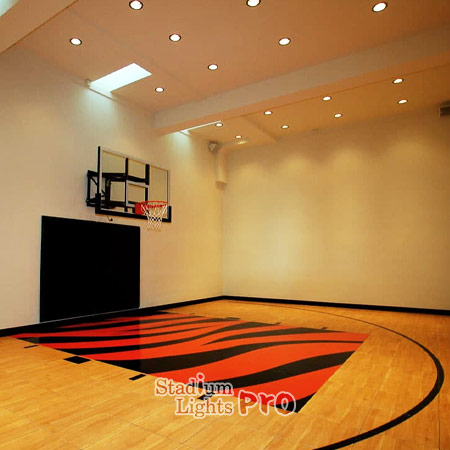 Recessed lights are a great option for an indoor basketball court because they provide bright, even lighting that is directed towards the playing surface. They are also flush with the ceiling, which means they won’t impede the movement of players or get in the way of the ball.
Recessed lights are a great option for an indoor basketball court because they provide bright, even lighting that is directed towards the playing surface. They are also flush with the ceiling, which means they won’t impede the movement of players or get in the way of the ball.
Some recommended options for recessed lights in a basketball gym include LED fixtures, which are energy efficient and have a long lifespan, and high-output fixtures, which provide brighter light. We may consult with a professional electrician to ensure that the lights are properly installed and meet safety and code requirements.
LED lights
LED (Light Emitting Diode) lights are energy-efficient and long-lasting lighting fixtures that are becoming increasingly popular in indoor basketball courts and other sports facilities. They are becoming the go-to option for indoor lighting due to their energy efficiency, high luminous efficacy, long lifespan, and low maintenance requirements.
LED basketball court lights provide high-quality light with a high color rendering index (CRI), which means that the colors of the court and the players’ uniforms are seen more accurately. They also have a high lumen output, which makes them ideal for illuminating the playing surface of an indoor basketball court.
Halogen lights
They are known for their bright, white light and high color rendering index (CRI), which makes them ideal for illuminating the playing surface of an indoor basketball court.
Halogen lights are relatively inexpensive and easy to install, which makes them a popular choice for many facilities. They have a relatively short lifespan compared to LED lights, typically around 2,000-4,000 hours, and they consume more energy than LED lights.
One of the merits of halogen lights is their high color rendering index (CRI), which means that the colors of the court and the players’ uniforms are seen more accurately. They also have a relatively low warm-up time, which means that they reach their full brightness level quickly.
However, halogen lights produce a lot of heat, which can cause discomfort in the court if not installed properly.
Recommended foot-candles for different areas of the basketball court/gym
The recommended level of light intensity, measured in lux or foot-candles, for indoor basketball courts varies depending on the level of competition and the standard that is being used. Here are some examples of recommended light levels for different levels of competitions:
- International Basketball Federation (FIBA) – recommends a minimum of 750 lux or 70 foot-candles on the playing surface for international competitions.
- National Basketball Association (NBA) and National Collegiate Athletic Association (NCAA) – recommends a minimum of 50 foot-candles on the playing surface for professional and college games.
- High school and recreational leagues – recommends a minimum of 30-50 foot-candles on the playing surface for games at this level.
These standards are the minimums recommended for the playing surface, other areas of the court, such as seating areas, may require different levels of light intensity. Besides, the design of the court and the location of lighting fixtures can also affect the overall light levels on the playing surface, so it is recommended to consult with lighting professionals to ensure that the court is properly illuminated.
Lumen required to light the indoor gym
The number of lumens needed to light an indoor basketball court depends on a number of factors, including the size of the court, the height of the ceiling, and the desired light level (measured in lux or foot-candles). Here’s an example of how to calculate the number of lumens needed to light an indoor basketball court, assuming the following:
- Court size: 94 feet x 50 feet (typical size of a high school or college basketball court)
- Ceiling height: 30 feet
- Desired light level: 50 foot-candles on the playing surface
- Reflectance of the playing surface: 0.75 (typical reflectance of a wood floor)
First, we need to convert the desired light level from foot-candles to lux:
1 foot-candle = 10.764 lux
So, 50 foot-candles = 538 lux
Next, we need to calculate the total area of the playing surface:
94 feet x 50 feet = 4700 square feet (or 437 square meter)
Now, we can use the formula:
Lumens = (lux x area) / reflectance
So, lumens required for an indoor basketball court = (538 x 437) / 0.75 = 313,400 lumens
This is the total number of lumens needed to light the playing surface of the basketball court to a level of 50 foot-candles.
How many watts to light an indoor basketball court?
As calculated above, in order to light an indoor basketball court to a level of 50 foot-candles on the playing surface, a total of 313,400 lumens are required. Assuming that the lights used are LED lights with an output of 160 lumens per watt, the total wattage required to light the court can be determined by dividing the total number of lumens needed by the number of lumens per watt of the LED lights.
To do this calculation, you can use the formula:
Wattage = Lumens / Lumens per watt
So, in this case:
Wattage of basketball court lights = 313,400 / 160 = 1,958 watts
This is the total wattage required to light the indoor basketball court using LED lights with an output of 160 lumens per watt. This is just an example calculation and the final wattage required will depend on the specific design of the court, the location of the lighting fixtures, and the reflectance of the surfaces in the court. Also, the number of lights used and their location in the court will also affect the final wattage required.
Lighting uniformity requirement
Lighting uniformity is a measure of how evenly light is distributed across the playing surface of an indoor basketball court. The playing surface is evenly illuminated to prevent glare and shadows, which can affect the performance and safety of the players. The recommended lighting uniformity for indoor basketball courts varies depending on the level of competition and the standard that is being used. Here are some examples of recommended lighting uniformity for different levels of competitions:
| Level of competitions | Lighting uniformity required |
| International Basketball Federation (FIBA) | 0.6 to 0.7 |
| National Basketball Association (NBA) | 0.6 to 0.7 |
| High school and recreational leagues | 0.5 |
Color temperature standards
The color temperature of 4,000K to 5,000K is considered as neutral white light, which is suitable for most sports and general lighting applications, it provides a balanced spectrum of light that allows the players to see the ball and the court with good contrast, and also it does not affect the color of the skin and the uniforms of the players. Here are some examples of recommended color temperatures for different levels of competitions:
| Level of competitions | Color temperature standards |
| International Basketball Federation (FIBA) | 4,000K to 5,000K |
| National Basketball Association (NBA) | 4,000K to 5,000K |
| High school and recreational leagues | 4,000K |
Lighting control design options
There are several lighting control options available for indoor basketball gyms that can help to improve energy efficiency and create the desired ambiance in the court.
Dimmable lighting
Dimmable lights allow users to adjust the brightness levels of the lights, which can provide flexibility in creating the desired ambiance in the indoor basketball court. This is particularly useful during different times of the day or during different events, as the lighting can be adjusted to suit the specific needs of the event or activity.
For example, during a basketball game, the lights can be set to a high level to provide optimal visibility for the players and the spectators, while during a practice session, the lights can be set to a lower level to reduce glare and eye strain for the players.
Besides, during a cleaning session, the lights can be dimmed to reduce the amount of light that is needed and save energy.
Occupancy sensors
Occupancy sensors detect the presence of people in the room and automatically turn the lights on and off as needed. This can help to save energy by reducing the amount of time that lights are left on when the court is not in use.
Timers
Timers can be set to automatically turn lights on and off at specific times, which can help to save energy by limiting the amount of time that lights are left on when the court is not being used. This can be an effective way to conserve energy and reduce costs, as lights left on unnecessarily can account for a significant portion of a building’s energy consumption.
Light-level sensors
Light-level sensors can automatically adjust the brightness of the lights in response to changes in natural light, which can help to save energy by reducing the amount of artificial light needed during daylight hours.
Remote control
Remote control allows the users to control the lights from different locations in the court and set different scenes for different events.
Zone control
Zone control allows for different areas of the court to be controlled independently, which can be useful for creating different lighting levels for different areas of the court, such as the playing surface, seating areas, and entryways.
Building Management System (BMS) integration
A BMS is a computerized system that integrates and controls all the building’s mechanical and electrical equipment such as HVAC, lighting, and security. It allows for the centralization of control and monitoring of all the lighting fixtures in the court, and allows for automation of the lighting system and energy management.
Smart control
Smart control systems allow for the lights in an indoor basketball court to be controlled through a smartphone or tablet app, which can provide a convenient and user-friendly way to manage the lighting system. The app typically allows users to adjust the brightness, color temperature, and other settings of the lights remotely, and also allows to schedule when the lights should turn on/off.
Moreover, smart lighting control systems can also allow users to set different lighting scenes for different events or activities, such as a training mode, a game mode, or a cleaning mode. This can enable users to easily adjust the lighting to suit the specific needs of the event or activity, and can help to create the desired ambiance in the court.
Energy efficiency considerations
Energy efficiency is a necessary consideration when designing the lighting for an indoor basketball court. Here are some examples of how to make the lighting more energy efficient:
- Use energy-efficient light sources – LED lights are more energy-efficient than traditional incandescent or metal halide lights. They consume less energy and have a longer lifespan, which can result in significant cost savings over time.
- Control the lighting – By using lighting control options such as occupancy sensors, timers, and light-level sensors, the lights can be turned off or dimmed when they are not needed, which can help to reduce energy consumption.
- Use appropriate light levels – By selecting the appropriate light level for the specific activity, it’s possible to reduce energy consumption while still providing sufficient lighting.
- Lighting maintenance – Regular maintenance of the lighting fixtures, such as cleaning the lenses and replacing burnt-out lamps, can help to ensure that the lights are working at their full potential, which can result in energy savings.
- Lighting design -Proper lighting design can help to reduce the number of fixtures required to achieve the desired light levels, which can also help to reduce energy consumption.
- Use of smart control systems – Smart control systems can help to monitor and control the lighting in the court, and can provide insights on energy consumption and help to identify ways to improve energy efficiency.
Lighting layout for indoor basketball gym
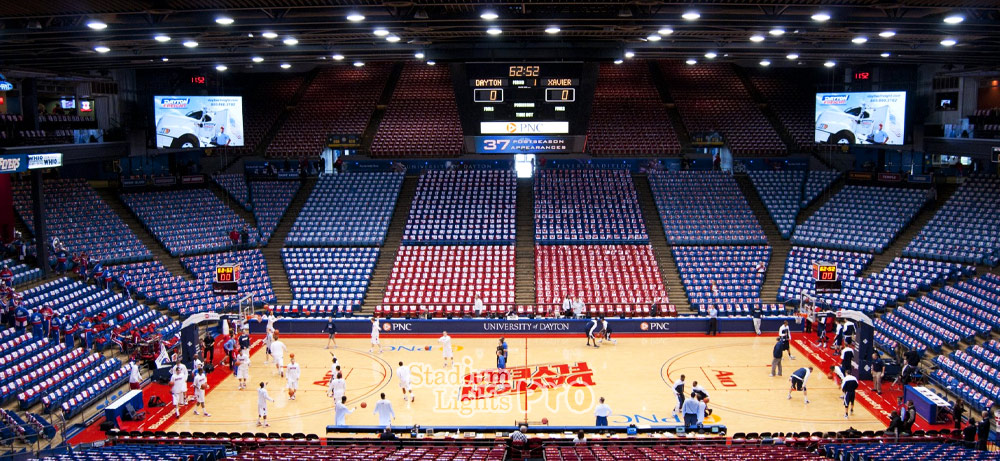
Lighting layout refers to the placement and arrangement of lighting fixtures in an indoor basketball court. It includes the selection of the appropriate type and number of fixtures, the positioning of the fixtures in the court, and the aiming of the fixtures to achieve the desired light levels and uniformity.
The lighting layout is a crucial aspect of the overall lighting design, as it can greatly impact the energy efficiency, safety, and visual comfort of the court. A proper lighting layout can help to minimize glare, reduce shadows, and ensure that the playing surface and other areas of the court are evenly illuminated.
It typically involves the use of lighting calculation software, which can help to determine the number of fixtures required, the spacing of the fixtures, and the aiming of the fixtures to achieve the desired light levels and uniformity. The software takes into account factors such as the size of the court, the height of the ceiling, the reflectance of the surfaces, and the desired light levels.
Placement of indoor basketball lighting fixtures
It involves determining the appropriate location for the fixtures in the court, taking into account factors such as the size of the court, the height of the ceiling, the reflectance of the surfaces, and the desired light levels.
The following are some general guidelines for the placement of lighting fixtures in an indoor basketball court:
The fixtures should be positioned in such a way that –
- they provide the desired light levels and uniformity on the playing surface.
- they are easy to maintain and access for replacement of lamps and cleaning of lenses.
- they do not interfere with the sightlines of the spectators.
The fixtures should be located at –
- a sufficient distance away from the court to avoid glare and shadows on the playing surface.
- an appropriate height above the court to provide the desired light levels and uniformity.
Avoiding glare and shadows on the playing surface
Glare and shadows can affect the performance and safety of the players, and can also be a distraction for the spectators. Here are some ways to avoid glare and shadows on the playing surface:
Proper positioning of fixtures
Lighting fixtures should be positioned in such a way that they do not cause direct glare on the playing surface. This can be achieved by positioning the fixtures at a sufficient distance away from the court and at a sufficient height above the court.
Aiming of fixtures
The aiming of fixtures should be done in such a way that the light is directed towards the playing surface and not towards the seating areas or other areas of the court. This can be achieved by using optics and reflectors that are designed to direct the light towards the playing surface and minimize glare.
Use of shields and louvers
The use of shields and louvers on the fixtures can help to reduce the amount of light that is directed towards the seating areas and other areas of the indoor basketball court, which can help to minimize glare and shadows.
Use of dimmable lights
Dimmable lights can be adjusted to different brightness levels, which allows for flexibility in creating the desired ambiance in the court. This can be especially useful for adjusting the lighting during different times of the day or during different events.
Providing sufficient lighting for seating areas and other non-playing areas
Adequate lighting in these areas can enhance the overall experience for the spectators and also help to ensure safety and security in the court. Here are some ways to provide sufficient lighting for seating areas and other non-playing areas:
Use of task lighting
Task lighting can be used to provide additional lighting in specific areas, such as seating areas, concourses, and entryways. This can help to ensure that these areas are well-lit and easy to navigate.
Use of accent lighting
Accent lighting can be used to highlight specific architectural or decorative features in the court, such as artwork, signage, or architectural elements. This can help to create an attractive and visually appealing environment in the court.
Use of decorative lighting
Decorative lighting can be used to enhance the ambiance in the court, such as rope lights, chandeliers or pendants.
Use of emergency lighting
Emergency lighting should be provided in the court to ensure that the court is well-lit in case of power outages or other emergencies.
Maintenance
Regular cleaning and maintenance of lighting fixtures
Proper cleaning and maintenance can help to ensure that the lights are working at their full potential and can help to prolong the lifespan of the fixtures.
Cleaning of lenses
The lenses of the fixtures should be cleaned regularly to remove dirt and dust, which can accumulate over time and reduce the amount of light that is emitted from the fixtures.
Replacement of burnt-out lamps
Burnt-out lamps should be replaced as soon as possible to ensure that the fixtures are working at their full potential.
Inspection of fixtures
The fixtures should be inspected regularly for any damage or wear and tear, such as loose or broken components, and should be repaired or replaced as needed.
Adjustment of aiming
The aiming of the fixtures should be checked regularly to ensure that the light is directed towards the playing surface and not towards the seating areas or other areas of the court.
Keeping a maintenance schedule
Keeping a regular schedule for cleaning and maintenance of the lighting fixtures can help to ensure that the fixtures are properly maintained and that any issues are addressed in a timely manner.
Upgrading or replacing fixtures as necessary
Over time, lighting fixtures may become worn out or obsolete, and may need to be replaced to ensure that the court is properly illuminated and safe for the users.
- End of lifespan of the fixtures – Lighting fixtures have a specific lifespan, after which the efficacy of the light will decrease, and the fixtures will need to be replaced.
- Advancement in technology – As new lighting technologies become available, upgrading or replacing the existing fixtures can help to increase energy efficiency and reduce costs.
- Changes in the court design – If there are changes made to the court design, such as a change in the playing surface or the addition of new seating areas, the fixtures may need to be upgraded or replaced to ensure that the court is properly illuminated and safe for the users.
- Energy efficiency – If the existing fixtures are outdated and not energy-efficient, upgrading or replacing the fixtures can help to reduce energy costs and improve energy efficiency
- Maintenance and repair costs – If the cost of maintaining and repairing the existing fixtures becomes excessive, it may be more cost-effective to upgrade or replace the fixtures.
Grants of basketball court lighting
Where can I apply for a basketball court lighting grant?
There are various organizations and government agencies that offer grants for indoor basketball court or gym lighting projects.
- Federal government
- State government
- Local government
- Non-profit organizations
- Private foundations
- Energy service companies (ESCOs)
How to apply the grants?
Applying for grants for indoor basketball court or gym lighting can be a good way to help fund the cost of upgrading or replacing existing lighting fixtures. Here are some steps to follow when applying for grants:
Research available grants
There are various organizations and government agencies that offer grants for indoor basketball court or gym lighting. It’s suggested to research the available grants to determine which ones are the most suitable for your project.
Review the grant requirements
Each grant has specific requirements that need to be met in order to be eligible for the funding. We need to review the requirements to ensure that your project meets the criteria.
Gather necessary documents
Many grants require applicants to submit various documents, such as a business plan, financial statements, and project budgets. We may gather all necessary documents before applying for the grant.
Prepare a grant application
The grant application should clearly outline the project, including the scope of the work, the budget, and the expected outcomes. It should also demonstrate how the project aligns with the grant’s requirements and goals.
Submit the application
Once the application is completed, it should be submitted to the grant-making organization by the deadline.
Follow-up
After submitting the application, it’s necessary to follow up with the grant-making organization to ensure that the application has been received and to find out the status of the application.
Conclusion
The lighting design should take into account factors such as light levels, uniformity, color temperature, and type of lights used. The design should also consider how to avoid glare and shadows on the playing surface, provide sufficient lighting for seating areas and other non-playing areas, and comply with local building codes and safety regulations.
We understand the importance of proper lighting design for indoor basketball courts and gyms. That is why we offer a free service to design the lighting solution for your indoor basketball court. Our team of lighting experts will work with you to create a custom design that takes into account factors such as light levels, uniformity, color temperature, and type of lights used.
We will also ensure that the design avoids glare and shadows on the playing surface, provides sufficient lighting for seating areas and other non-playing areas, and complies with local building codes and safety regulations.
Moreover, we will provide guidance on regular cleaning and maintenance of lighting fixtures and upgrading or replacing fixtures as necessary. We are dedicated to ensuring that your indoor basketball court is properly illuminated and safe for the users. Don’t hesitate to reach out to us for more information or to schedule a consultation for your indoor basketball court lighting design.

